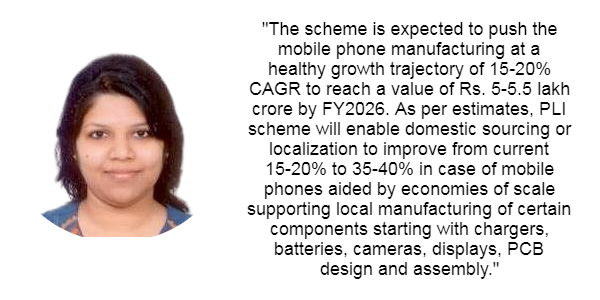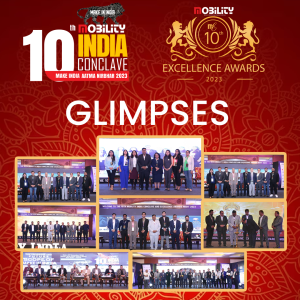As per ICRA’s analysis, a healthy participation in the second round would help improve India’s electronics component ecosystem reducing import dependence and improving value addition. The scheme is expected to push the mobile phone manufacturing at a healthy growth trajectory of 15-20% CAGR to reach a value of Rs. 5-5.5 lakh crore by FY2026.
The scheme intends to offer incentives of 4-6% on incremental sales over a period of 5 years provided that the shortlisted players meet set thresholds of incremental revenues and investments subsequent to base year. Under the mobile phone segment, the scheme targets two categories of mobile phone manufacturers – Category 1 of 5 Global OEM players with gross manufacturing revenue (GMR) > Rs. 10,000 crore and category 2 of 5 domestic companies with GMR > Rs. 100 crores.

As things stand currently, India has emerged as the second largest manufacturer of mobile handsets in the world in terms of volumes after China, growing at a CAGR of 50% during FY2015-21 on a low base. Although, the country witnessed considerable growth in production, the amount of value addition remained low as almost 80-90% of the components continue to be manufactured outside due to weak component manufacturing ecosystem. Key challenges faced by manufacturers in India include lack of R&D infrastructure, high capital and logistics costs, muted private sector interest and weak backward linkages.
Under electronics component segment, 10 players with GMR > Rs. 50 crore are proposed to be selected. In the first round, 16 players have been approved – 5 players each under Category-1 and Category -2 of Mobile phones and 6 players under components segment. With the success of first round, GoI introduced the second round of Production Linked Incentive (PLI) scheme in March 2021 focused and only on electronic components such as active semiconductor components, passive components, PCB assemblies etc. The eligibility to apply for incentives under the second-round scheme is contingent on relaxed threshold criteria and incentives of 3-5% of incremental sales. The tenor of scheme would be four years, compared to five years for the players shortlisted in the first round. The second round has expanded the window for up to 30 eligible companies. For the second round of PLI, the eligible companies can choose any 4 years between FY2021 and FY2026 for incentives on incremental sales. As per ICRA’s analysis, a healthy participation in the second round would help improve India’s electronics component ecosystem reducing import dependence and improving value addition.

The Government of India introduced Production Linked Incentive (PLI) for Large Scale Electronics Manufacturing in April 2020 primarily targeting mobile phones and specified electronic components as product categories with a cumulative outlay of Rs. 38,601 crore.
There were concerns of some key players towards ability in meeting qualification criteria of incremental sales in FY2021 due to pandemic related disruptions, travel restrictions and acute global chip shortage. Subsequently, GoI extended the tenor of PLI scheme till FY2026 and the shortlisted players are now allowed to choose any 5 consecutive years between FY2021 and FY2026 to achieve threshold targets for incremental sales though base year remains FY2020. Investments made in FY2021 will continue to be counted as eligible investments.
Although, the country witnessed considerable growth in production, the amount of value addition remained low as almost 80-90% of the components continue to be manufactured outside due to weak component manufacturing ecosystem. Key challenges faced by manufacturers in India include lack of R&D infrastructure, high capital and logistics costs, muted private sector interest and weak backward linkages. Moreover, the impact of Covid-19 pandemic waves was felt across geographies which disrupted mobile phone supply chain which is highly reliant on few geographies such as China, Vietnam, Taiwan etc. This prompted OEMs to improve geographical diversification of their manufacturing operations. India, with its ample manpower and under-penetrated market, would attract these OEMs to shift their manufacturing, thus, increasing country’s contribution to the global mobile phone production.
Adds, Ms. Sharad, “The incremental sales and investments-based incentives would enable the domestic and global players to ramp up their production. However, Covid-19 pandemic induced supply chain disruptions, impact on demand and availability of skilled manpower might create hurdles to meet production and export targets. The new Covid-19 waves in China and Russia-Ukraine conflict is expected to exacerbate the component shortage in the near term. Apart from supply chain challenges, higher customs duty on imported components could impact the cost competitiveness of mobile phone manufacturers from exports perspective. From demand perspective, 5G rollout in 2022 and easy financing would create replacement demand for the mobile phones. Further, the Government through its electronics manufacturing focused skill development programmes, and capital support policies would support capacity building in the medium term.”
In a nutshell
This initiative is bound to pave the employment opportunities in India and the government would also boost the manufacturing sector through its electronics manufacturing focused skill development programmes. This will lessen the dependency on the other countries.






